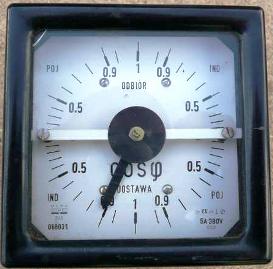What is Power Factor (Cosine Phi)
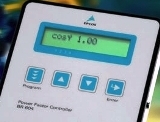 A natural person's power factor (cosine phi) is as follows. As you know, in an AC circuit, there are generally three types of load or three types of power (three types of current, three types of resistance). Active P, reactive Q, and total C powers are related to active r, reactive x, and total z resistance, respectively.
A natural person's power factor (cosine phi) is as follows. As you know, in an AC circuit, there are generally three types of load or three types of power (three types of current, three types of resistance). Active P, reactive Q, and total C powers are related to active r, reactive x, and total z resistance, respectively.
It is known from the course of electrical engineering that the resistance is called active, in which heat is released when current passes. Active resistance is associated with active power losses dPnEqual to the square of the current multiplied by the resistance dPn = Az2r W
Reactance when current flows through it, it causes no losses. This resistance is due to inductance L as well as capacitance C.
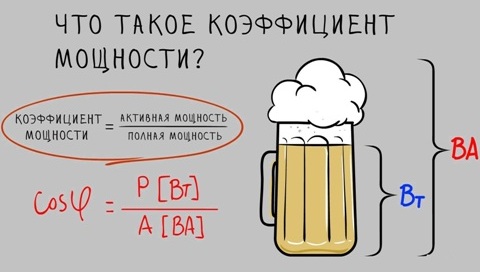
Inductive and capacitive resistance are two types of reactance and are expressed by the following formulas:
-
reactance or inductive resistance,
-
capacitive resistance or capacitance,
Then x = xL — НС° С… For example, if in the circuit xL= 12 Ohm, xc = 7 Ohm, then the reactance of the circuit x = xL — NSc= 12 — 7 = 5 Ohm.
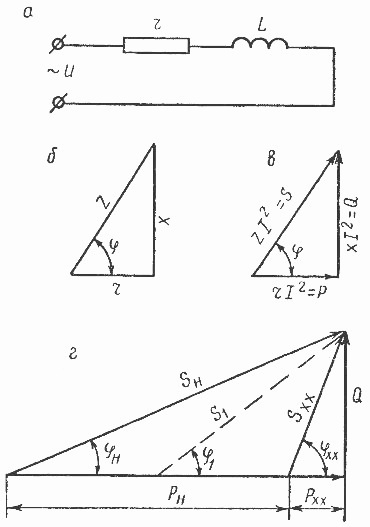
Rice. 1. Illustrations to explain the essence of cosine «phi»: a — circuit of series connection of r and L in an alternating current circuit, b — triangle of resistance, c — triangle of power, d — triangle of power at different values of active power.
The impedance z includes resistance and reactance. For a series connection of r and L (Fig. 1, a), a resistance triangle is graphically depicted.
If the sides of this triangle are multiplied by the square of the same current, then the ratio will not change, but the new triangle will be a capacity triangle (Fig. 1, c). Check more details here — Triangles of resistances, voltages and powers
As seen from the triangle, in an AC circuit, three powers generally occur: active P, reactive Q and total S
P = Az2r = UIcosphy W,B = Az2x = Az2NSL — I2x° C = UIsin Var, S = Az2z = UIWhat.
Active power can be called working power, that is, it "heats" (emission of heat), "lights" (electric lighting), "moves" (electric motor drives), etc. It is measured in the same way as constant power, in watts.
Developed active powerb completely without a trace is consumed in receivers and lead wires at the speed of light — almost instantaneously. This is one of the characteristic features of active power: as much as it is generated, so much is consumed.
Reactive power Q is not consumed and represents the oscillation of electromagnetic energy in an electrical circuit.The flow of energy from the source to the receiver and vice versa is related to the flow of current through the wires, and since the wires have active resistance, there are losses in them.
Thus, with reactive power, work is not carried out, but losses occur, which for the same active power, the greater, the smaller the power factor (cosphi, cosine «phi»).
An example. Determine the power loss in a line with resistance rl = 1 ohm if power P = 10 kW is transmitted through it at a voltage of 400 V once at cosphi1 = 0.5 and the second time at cosphi2 = 0.9.
Answer. Current in the first case I1 = P / (Ucosphi1) = 10/(0.4•0.5) = 50 A.
Power loss dP1 = Az12rl = 502•1 = 2500 W = 2.5 kW.
In the second case, the current Az1 = P / (Ucosphi2) = 10/(0.4•0.9) = 28 A.
Power loss dP2 = Az22rl = 282•1 = 784 W = 0.784 kW, i.e. in the second case the power loss is 2.5 / 0.784 = 3.2 times smaller only because the cosfi value is higher.
The calculation clearly shows that the higher the value of the cosine «phi», the lower the energy loss and the less need to place non-ferrous metals when installing new installations.
By increasing the cosine «phi» we have three main goals:
1) saving electrical energy,
2) saving non-ferrous metals,
3) maximum use of the installed power of generators, transformers and in general AC motors.
The last circumstance is confirmed by the fact that, for example, from the same transformer it is possible to obtain the more active power, the greater the value of cosfi users.So, from a transformer with a rated power Sn= 1000 kVa at cosfi1 = 0.7 you can get the active power P1 = Снcosfie1 = 1000 • 0.7 = 700 kW, and at cosfi2 = 0.95 R2 = Сncosfi2= 1000 • 0 .95 = 950 kW.
In both cases the transformer will be fully loaded to 1000 kVA. Induction motors and underload transformers are the cause of low power factor in factories. For example, an induction motor at idle speed has cosfixx approximately equal to 0.2, while when loaded to rated power of sfin = 0.85.
For greater clarity, consider an approximate power triangle for an induction motor (Fig. 1, d). During idle operation, the induction motor consumes reactive power approximately equal to 30% of the rated power, while the active power consumed in this case is about 15%. Therefore, the power factor is very low. As the load increases, the active power increases and the reactive power changes marginally and hence the cosfi increases. Read more about it here: Drive power factor
The main activity that increases the value of cosfi is operating at full production capacity. In this case, asynchronous motors will operate with power factors close to the nominal values.
Power factor improvement activities are divided into two main groups:
1) does not require installation of compensating devices and suitable in all cases (natural methods);
2) related to the use of compensating devices (artificial methods).
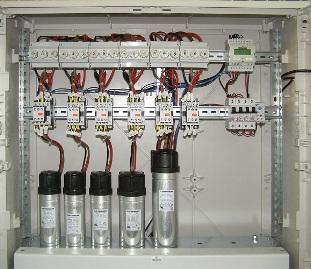 Condensing unit to increase the power factor
Condensing unit to increase the power factor
The activities of the first group, according to the current guidelines, include the rationalization of the technological process, leading to the improvement of the energy mode of the equipment and the increase of the power factor. The same measures include the use of synchronous motors instead of some asynchronous ones (the installation of synchronous motors instead of asynchronous ones is recommended where necessary to increase efficiency).
Also read on this topic: AC power supply and power losses

